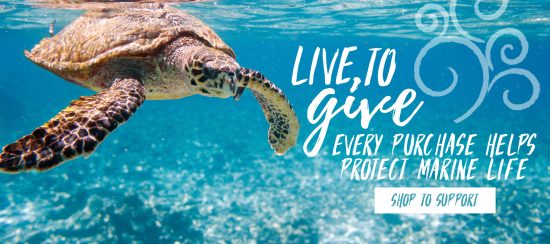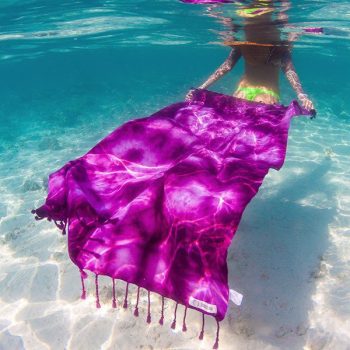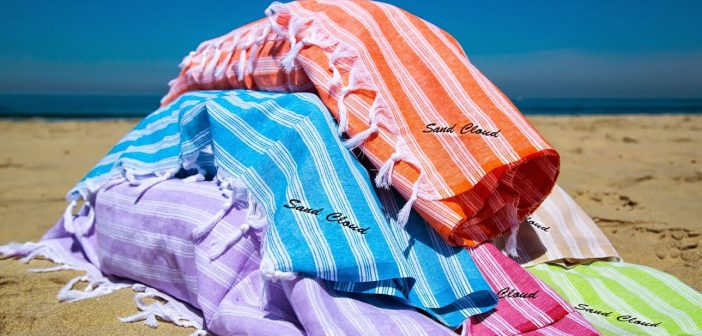A company’s mission to support marine life.
Bruno Aschimanini, Steven Ford, and Brandon Leibel were fresh out of school in 2014 when they decided that they wanted to start something of their own. One day, one of the founders was trying to take a nap on the beach. After trying for several minutes to get comfortable using his backpack as a pillow, it became clear, something had to be done. That was when the idea of Sand Cloud came to life.
As seen on Shark Tank, the three friends started their company as a way to solve the problem of being comfortable at the beach. In an email with the company, one of the Sand Cloud representatives described how the focus changed as they started selling their products: “The original concept was a beach towel with a pillow. That’s where the name SAND CLOUD came from. Since then, we realized it wasn’t the pillow towel people were interested in. It was the reason behind the product, giving back to marine life, and it was more the beautiful designs and creative ways to express themselves at the beach.”
The buy-to-give and buy-one-give-one business model
Sand Cloud’s mission is to protect the oceans and the marine life. “We believe in making the best quality product that has a positive impact. We want to give people a way to give back and help preserve marine life,” the Sand Cloud representative explains. Their products consist of their Turkish Towels that are handmade by local artisans in Turkey. Sand Cloud also offer accessories, which include water bottles, phone cases, and jewelry. They donate 10% of all sales to a variety of organizations that preserve and protect marine wildlife and habitats. One of the organizations that they support is the Marine Conservation Institute which is a non-profit organization dedicated to securing permanent, strong protection for the oceans’ most important places. Other organizations involved are the Surfrider Foundation, Pacific Marine Mammal Center, and the San Diego Coast keeper.
Sand Cloud is one of many companies that have adopted the buy-to-give business model. What these companies have created is the ability for their customers to combine a purchase with social change. Another known business model is the buy-one-give-one. When you purchase one of their products, the company donates a product to someone in need. At first glance, these companies seem to be doing something good, but they have had to face backlash for using these particular business models.
 “Just treating one symptom”
“Just treating one symptom”
These business models have been criticized by non-profit organizations who claim that these companies are designed more to create social capital for consumers than to actually make a positive global impact. There are some who are accusing these companies of caring more about creating customer loyalty and selling more products, and that they are over exaggerating on their actual charitable giving.
TOMS is the company that most people associate with the “buy-one-give-one” model. Their mission is simple; for every pair of shoes a customer purchases, another pair gets donated to a child in need. There has been a lot of controversy surrounding this particular business model. Some say the model was created to make Western consumers feel better about themselves by simply buying a product for their own personal use. Laura Seay, professor at Morehouse College, argues that by giving away millions of pairs of shoes, TOMS is “just treating one symptom of a much deeper problem, and treating symptoms is not a cure.” Some even claim that companies like TOMS are undermining the local economies in the countries where they give away shoes, ending up in destroying the existing footwear industries. Valeria Budinich, Vice President of Ashoka, a nonprofit that advises companies on social responsibility, told the New York Times that the buy-one-give-one model does little to address the root causes of poverty, and may even reduce demand for locally-produced products. There are several international experts that have questioned this model, letting people know that donating often create a dependency that can end up lasting forever.
Entrepreneur Chris Bahr created his company Just Porter to try and reinvent the “buy-one-give-one” business model. His company provides high quality backpacks that are manufactured in the country where they are donated. The backpacks are filled with essential school supplies and given to children. “Everything we do is focused on creating economic opportunity and enhancing education. By using local materials and local vendors whenever possible, we create jobs. And by giving out school supplies with the backpacks, we find that children are engaged, inspired and spend more time in school,” Chris explained in a press release. On the Just Porter website, the company explains that the “buy-one-give-one” model is just a temporary solution. Therefore, instead of just handing out his product, he found a way to invest in the well-being of a community’s economy.
Marketing through Social Media
Despite all the criticism, Bruno Aschimanini, Steven Ford, and Brandon Leibel were determined to start their business and try to make a difference. With no prior business experience, they did everything they could to get their business off the ground.
“We focused heavily on Social Media because we found it as a unique way to create a memorable user experience and engage with our followers. It’s been a huge learning experience and we are all still learning every day!”
One way they went about this was introducing “Brand Ambassadors”. If you go to their website and click the “Ambassador”-tab, it will allow you to apply to become an ambassador. If you are accepted, you get a discount code and you are encouraged to be a spokesperson for the company, by hashtagging them and mentioning them in your Instagram bio.
“Our ambassadors are one of the main drivers behind our brand! All of this has allowed us to make a bigger difference in giving back to marine life!” the company proudly states.






